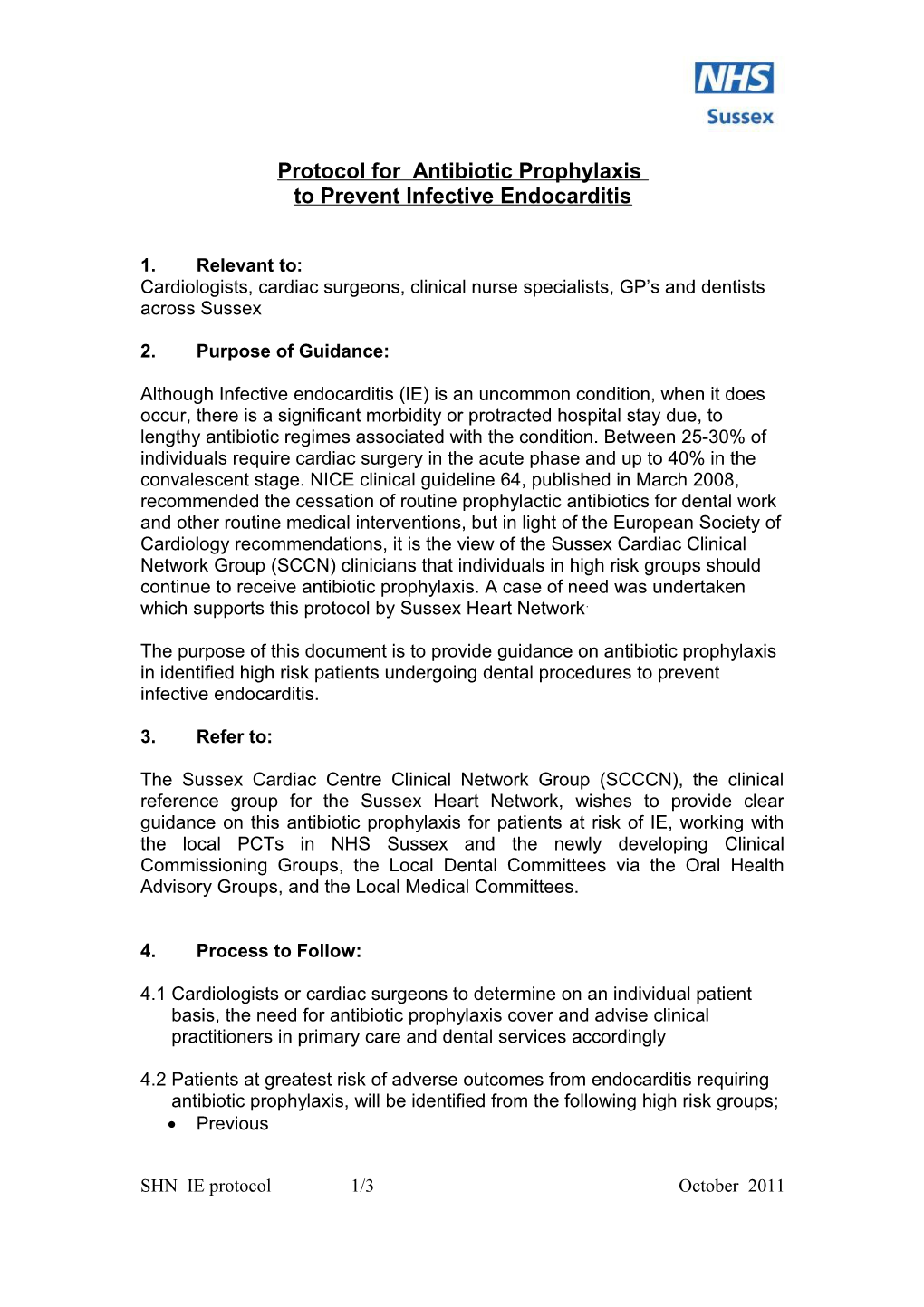Protocol for Antibiotic Prophylaxis
to Prevent Infective Endocarditis
1.Relevant to:
Cardiologists, cardiac surgeons, clinical nurse specialists, GP’s and dentists across Sussex
- Purpose of Guidance:
Although Infective endocarditis (IE) is an uncommon condition, when it does occur, there is a significant morbidity or protracted hospital stay due, to lengthy antibiotic regimes associated with the condition. Between 25-30% of individuals require cardiac surgery in the acute phase and up to 40% in the convalescent stage. NICE clinical guideline 64, published in March 2008, recommended the cessation of routine prophylactic antibiotics for dental work and other routine medical interventions, but in light of the European Society of Cardiology recommendations, it is the view of the Sussex Cardiac Clinical Network Group (SCCN) clinicians that individuals in high risk groups should continue to receive antibiotic prophylaxis. A case of need was undertaken which supports this protocol by Sussex Heart Network.
The purpose of this document is to provide guidance on antibiotic prophylaxis in identified high risk patients undergoing dental procedures to prevent infective endocarditis.
3.Refer to:
The Sussex Cardiac Centre Clinical Network Group (SCCCN), the clinical reference group for the Sussex Heart Network, wishes to provide clear guidance on this antibiotic prophylaxis for patients at risk of IE, working with the local PCTs in NHS Sussex and the newly developing Clinical Commissioning Groups, the Local Dental Committees via the Oral Health Advisory Groups, and the Local Medical Committees.
4.Process to Follow:
4.1 Cardiologists or cardiac surgeons to determine on an individual patient
basis, the need for antibiotic prophylaxis cover and advise clinical
practitioners in primary care and dental services accordingly
4.2 Patients at greatest risk of adverse outcomes from endocarditis requiring
antibiotic prophylaxis, will be identified from the following high risk groups;
- Previous
- Cyanotic heart disease
- Prosthetic valve or prosthetic material used for cardiac valve repair
4.3 Patients assessed at risk by cardiologists or cardiac surgeons will be
given a patient held card in the cardiac outpatients department
4.4 Cardiologists to advise GPs in writing of at risk patients and
that a card has been given to the patient
4.5 Prescribing of antibiotic prophylaxis should be :
- Amoxicillin 3g orally one hour pre-procedure (adult) or
- Clindamycin 600mg orally one hour pre-procedure (adult if penicillin allergic)
4.6 Clinicians need to stress to patients the importance of good dental
hygiene and dental reviews
4.7 Clinicians need to advise patients on avoiding body
tattoos and piercing
4.8 Information given to patients on dental hygiene, tattoos and piercing, to
be documented in cardiology and cardiothoracic letters
5.Monitoring compliance:
5.1 Through clinical audit in each NHS Trust that is also reported to the SCCCN group six monthly.
6. References/furthers sources of advice:
6.1 Published SCCCN clinical guidelines on the Sussex Heart Network
Website;
6.2 Guidelines on the prevention, diagnosis and treatment of infective
endocarditis. Eur Heart J; 30:2369-2413;
6.3 Prevention of infective endocarditis:guidelines from the American Heart
Association:A guideline from the American Heart Association rheumatic
fever, endocarditisand Kawasaki disease committee
Circulation2007;116:1736-1754;
6.4 Case of Need – Antiobiotic prophylaxis to prevent Infective Endocarditis Sussex Heart Network – SCCCN version 0.7; 16th September 2011.
Version Control
Version / Comments / Author / Date / Sent to1. / First daft of I.E. clinical protocol / JO / 11/7/11 / KP,RJ,EMc
2. / Agreed by RJ with 1 spelling and 1 grammar amendment / RJ / 02/08/11
3 / DT amendments re references / DT / 3/10/11 / KP; RJ
4 / A few minor amendments to Logo and support. / KP / 4/10/11 / Heart board
SHN IE protocol 1/3October 2011
